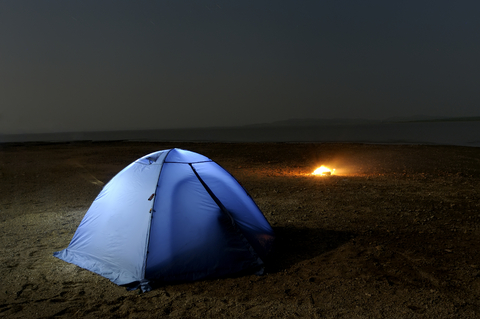
Death or injury is a real threat when someone with little outdoor experience becomes homeless in the dead of winter. Hundreds of people with multiple chemical sensitivity (MCS) will be homeless this year and many turn to camping for shelter. This guide is for those with moderate to severe MCS and little outdoor experience. It focuses on teaching the skills needed to survive safely until either housing improves or the weather warms in spring.
I have been living year-round in a tent since January 13, 2002, when I became severely ill from MCS and chronic fatigue syndrome (CFS). With my illnesses, safe and affordable housing is rare. Steep medicals costs make it nearly impossible to find.
Several years of tent living with severe illness in the Pacific Northwest has given me unique qualifications. I have lived through hard freezes, snowstorms, and torrential rains. For the first three years I had no electricity or heat. I remember those first winters being as bitter cold as they were beautiful.
These experiences have taught me skills that the MCS survivalist needs when living outdoors.
Part 1: Planning and Materials Needed
Large numbers of people with moderate to severe MCS find themselves unable to locate safe affordable housing. Section 8 or subsidized housing has long waiting lists; in several areas the list has been closed for years. Many with subsidized housing have no guarantee of safe housing that meets their special medical needs.
Thousands of MCS sufferers have few choices for safe housing when money is short. Homeless shelters are toxic for these survivors. Some live in their cars; others sleep on a relative’s porch when being inside the house makes them too ill.
For those with an adventuresome spirit there’s another way.
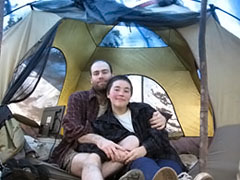 Living in a tent can provide alternative housing. To do this, you will need a safe place to camp. This can include a small spot in a friend’s yard, knowing someone with a large track of land, or conventional campgrounds.
Living in a tent can provide alternative housing. To do this, you will need a safe place to camp. This can include a small spot in a friend’s yard, knowing someone with a large track of land, or conventional campgrounds.
If you don’t know a campsite to use, there are websites on the Internet that can suggest campgrounds in your area. Another alternative is to camp secretively on secluded private land or other similarly restricted areas, but this comes with unique dangers and I don’t recommend it.
A Tent:
The first item needed is shelter. Unfortunately flame retardant or waterproofing chemicals coat most new tents. Polyurethane makes tent fabric waterproof; it’s the gummy residue found on the rain fly, seams, and often floors. It doesn’t wash off and can take years to off-gas. This fabric treatment is the main problem when using a new tent.
Occasionally they come with a DWR (Durable Water Repellent) sprayed on the walls and roof. Washing it off takes time and effort, also making a new tent difficult to use. I have recently read of a newer waterproof tent fabric called silnylon, but I haven’t tested it yet. This fabric is usually made into small pup or tipi style tents.
Other tenting materials include untreated and treated cotton canvas, leather, and vinyl. Each of these materials can present health concerns in those already ill.
A used tent is preferable to a new tent. It will keep you dry and protected from the elements when correctly pitched with a waterproof tarp. Steer clear of known major triggers, but try to be more forgiving of light odors on it, as shelter is of key importance.
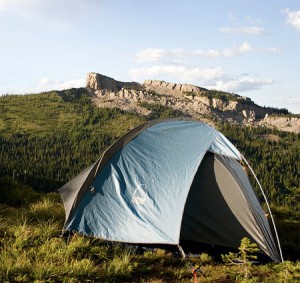 There are many places to look for used tents. Craigslist, newspapers, thrift stores, even pawnshops will sometimes have them for sale. It’s a gamble to buy a used tent unseen; they can be moldy, have holes, or be toxic so try to view it first.
There are many places to look for used tents. Craigslist, newspapers, thrift stores, even pawnshops will sometimes have them for sale. It’s a gamble to buy a used tent unseen; they can be moldy, have holes, or be toxic so try to view it first.
When picking out tent size, consider how to heat it. Will there be a heater, wood stove, or only body heat? A smaller tent, while less comfortable, will be much warmer, especially if you lack a direct heat source. In a small tent body heat can noticeably raise the indoor temperature.
If unable to find a tent, a tarp A-frame can be temporary shelter while continuing to look for one. Camping stores sell colorful woven tarps in different sizes and most hardware stores carry clear tarps called plastic sheeting. The sheeting comes in 10ft or 20ft widths in various lengths and two thicknesses. The main difference between 4 and 6 mil sheeting is the 6 mil is more durable, but either will work.
Clear tarps off-gas less than colorful woven ones even though both are made from polyethylene plastic.
With only a plastic tarp and a few lengths of rope, you have the means for a small A-frame style shelter. It isn’t perfect, but it will keep you out of the worst weather. By getting creative and making doors to cover the ends, or putting extra sheet plastic on the ground for a floor, the interior space will be warmer than the outside temperature.
Tarps:
The plastic sheeting also works as a simple tarp over tents. In my camp, I use it with a woven tarp that aired for several years. The two layers are 100% waterproof and provide support for each other, which allows for a larger area to remain dry.
Always tie a tarp out; never leave it draped over the tent. A draped tarp lets rain run under the tent floor or even inside. When setting-up a tarp, first lay it over the tent or a central line tied between two trees. Using rope or twine, tie each corner either to stakes or nearby trees. Shorten the ropes as needed until the tarp hangs taunt over the tent when finished. Depending on size, it may be necessary to tie out extra spots along the edges for proper tautness.
When using plastic sheeting, it won’t have grommet holes for tying the rope to the tarp. Instead, tie a simple overhand knot into each corner of the plastic, and then tie the rope onto the corner just behind the knot. Another style is to put a pebble in the corner, roll the plastic over it, and tie the rope above the rock.
In an area with heavy rains, make sure the fully tied tarp is at least 4 feet wider than the tent on all sides. Also keep an eye on water drainage or rain runoff may collect under the tent, and eventually leak inside. To combat this, dig small trenches around the tent perimeter to guide the water away.
Another frequent problem is rain pooling along the edges and corners of a tarp, even when properly hung. The water weight can become great and cause tent poles or tarp lines to snap under the strain. One way to handle this is to use your finger or other blunt object to make a small drain hole at the problem locations. The plastic sheeting will self-seal around a hole made by blunt objects, preventing further tearing. However, cutting it with a knife can cause it to later tear further. Use care if putting holes into a woven tarp because it could affect the integrity.
Cooking:
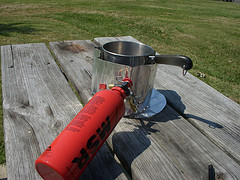 There are several ways to cook food outdoors. The first few years I didn’t have electricity and propane was too toxic. I tried cooking on an open fire and two different types of wood stove. At first it worked well, but after a year the smoke was making me too ill. I switched to a portable white gas stove until an electric hot plate could replace it a couple years later.
There are several ways to cook food outdoors. The first few years I didn’t have electricity and propane was too toxic. I tried cooking on an open fire and two different types of wood stove. At first it worked well, but after a year the smoke was making me too ill. I switched to a portable white gas stove until an electric hot plate could replace it a couple years later.
Don’t put a wood burning stove or open fire under your tarps. Some websites show open fires under the tarp, but I don’t recommend it. Burning wood for heat or cooking has several disadvantages. First, many people don’t tolerate wood smoke and it can aggravate existing medical conditions. Second, it’s hard work to split and haul wood. Last, it will be difficult to stay warm without an expensive stove that doesn’t need as much attention, unless the fire is stoked throughout the night.
Other options are camping stoves that use various types of fuel such as butane, propane, or white gas. If possible, you will want one that runs on white gas instead of other forms of fuel. White gas burns cleaner than similar fuels for camp stoves. Many people with MCS are sensitive to combustion by-products, like smoke from a fire, making it important to use the least toxic choice. If you have access to electricity, a good hot plate will make cooking a breeze.
Warm Clothing:
 Warm clothing is essential to survival. Synthetic or wool fabric is best because they are warm even when wet. Polypropylene, capilene, and polyester fleece are good choices for synthetic fabrics.
Warm clothing is essential to survival. Synthetic or wool fabric is best because they are warm even when wet. Polypropylene, capilene, and polyester fleece are good choices for synthetic fabrics.
A wise wilderness saying is – “Cotton Kills!” Cotton is the worst possible choice for clothing, though I suspect hemp isn’t far behind. This is because wet cotton wicks heat away from skin, attracts more moisture, and is harder to dry. Although it may seem extreme to avoid all cotton, if you are camping in a tent with no direct heat source, you need to take extreme precautions against hypothermia.
Layering clothing is better than using one bulky item as it offers more choice based on temperature. At night, layers can be stripped off for sleeping more comfortably while staying warm. One of the most important layers is a hat because the human body loses up to 30% of its heat through the head. Thermal underwear makes a good first layer, then use heavier fabrics on top. If a tolerated winter coat wasn’t found, it’s possible to stay warm with extra layers.
A Warm Bed:
Blankets can be a difficult item to find. They are too bulky to wash in a bucket and used ones often reek of laundry detergents or fabric softeners making them intolerable for use. Here is another area that synthetic fabrics outperform cotton. Some people report luck with sleeping bags from Wiggy’s in Colorado. I haven’t tested them, but the use of an adhesive in the manufacturing process concerns me.
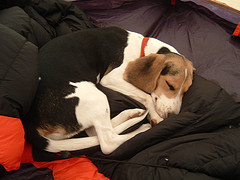 My bedding consists of three thin blankets laid out underneath me. On top are an unzipped synthetic sleeping bag (used), a thick cotton flannel sheet, and two polyester fleece blankets. Having the cotton layer sandwiched between synthetic layers removes many of the normal problems from using it. Although my comfort would benefit from more robust bedding, my main concern is staying warm.
My bedding consists of three thin blankets laid out underneath me. On top are an unzipped synthetic sleeping bag (used), a thick cotton flannel sheet, and two polyester fleece blankets. Having the cotton layer sandwiched between synthetic layers removes many of the normal problems from using it. Although my comfort would benefit from more robust bedding, my main concern is staying warm.
Using a mylar space blanket (emergency blanket) on top of other blankets is amazingly warm in deep winter without heating.
Having insulation under the bed is optional, but will always give a better night’s rest. Sleeping directly on the tent floor allows the dirt underneath to leech heat from bedding during the night, leaving you achy and cold by morning. Should the outside temperatures fall below freezing, the ground can freeze as well, and create an incredibly cold bed.
A closed cell foam pad, air mattress, pallet, or even untreated 2”x6” board lumber are bed insulation. It gets bedding off the ground and holds body heat while sleeping. Currently I use a handmade straw pallet, but for the first three years I was on 2 x 6’s laid under the tent floor. They kept me warmer while also being slightly more comfortable than bare dirt.
Food Storage:
Ensuring that food remains safe is important. This means protecting it from common spoilage; as well as critters such as mice, raccoons, or even bears. Having a large storage box or ice chest for food is much easier than hanging it in a bag on a nearby tree. In locations with frequent bear visits, people use a metal ‘bear box’ or hang their food in a tree. Bear safety is extremely serious as severe injury or death is possible. A bear will easily tear through your tent or car to get the food stored in it.
 Mice and other small animals can be a problem (even skunks), so make sure to keep all food covered and the area clean to deter them from visiting. Some mice have Hantaviruses in their feces that can infect humans. Using mousetraps may seem cruel or messy, but getting ill from an easily preventable virus isn’t surviving.
Mice and other small animals can be a problem (even skunks), so make sure to keep all food covered and the area clean to deter them from visiting. Some mice have Hantaviruses in their feces that can infect humans. Using mousetraps may seem cruel or messy, but getting ill from an easily preventable virus isn’t surviving.
Other Items Needed:
There are many types of camping gear to choose from and it can be hard to narrow down the choices. This is a short list of the gear you need to ensure survival.
Previously listed items:
• Shelter
• Tarp
• Stove for cooking
• Warm clothing
• Blankets or sleeping bags
• Bed insulation
• Food box
Other items you will want:
• Rope or nylon twine (100ft minimum, more if hanging your food)
• A shovel – folding or average garden shovel (not a gardening trowel)
• Buckets or plastic bags to keep your supplies dry
• Simple food to cook, which limits time outside getting cold or wet
• Cook pot, dishes for eating, etc
• Container for clean water
• Soap for washing dishes, clothing, and yourself
• Towels, cloth or paper
• A good pocket or belt knife with sharpener
• Flashlight or candles
• Lighter or matches with spares in case they become wet
• Rain protection if in a wet climate
Although a knife sharpener isn’t vital, knives quickly dull with outdoor use. Any cheap sharpener will work, however some are safer to use or will give a sharper edge. Use caution if you have never used a knife sharpener before, because it’s easy to get cut when using one.
Fun Time:
Cooped up in a tent for days on end while it’s pouring rain outside can stretch the hours in a day without something to help fill the time, especially without electricity. You should try to bring along a small portable radio, books, cards, dice, and anything else you can find for entertainment.
Life slows down when living outdoors. There is more time to listen to the birds in the morning, watch the snow falling, and absorb all that is Nature. Learning to enjoy these slower moments is part of the joy in outdoor life.
Further information:
• Campgrounds – I had hoped to find an all encompassing website for tent camping, but unfortunately they focused mainly on RVs. Each state’s Department of Natural Resources is a good place to find information on state and national parks in the area. Most state and national parks have camping in designated areas, though budget cuts are changing this quickly. There are also state specific websites for campgrounds. One place, Woodall’s, offers search options to narrow down to tent camping sites.
• Two silnylon tipi manufacturers – These tipi’s are wood stove compatible, come in various sizes, but are not cheap. Kifaru Tipis and Titanium Goat
• Plastic Sheeting at Home Depot
• The A-Frame Tarp Shelter: Simple, Lightweight and Effective offers tips on setting up an A-frame shelter.
• Basic Shelter and Camping Knots – Three basic knots for many different situations.
• All About Hantaviruses – An informative page at the CDC.
• Food Handling and Storage Strategies offers more details into what bears like, how to protect food from them, and their dangers.
• Fiskar Axe and Knife Sharpener – I have been happy with it as it works well on my hatchet, axe, and pocket knife.
• A Mini-list of Frequently Asked Questions Regarding Clothing is a brief overview of clothing do’s and don’ts when outdoors in winter.
Places I shop for outdoor clothing and gear:
• REI (high quality, higher prices)
• REI-Outlet (good deals sometimes)
• Sierra Trading Post (excellent prices, limited supply)
• Bass Pro Shops (some good deals)
• Cabela’s (clothing needs more time to air, decent prices)
read Part 2:
The MCS Survivalist Guide: Tent Living – Part 2
photo credits: Tent Living © Wenbin Yu/ Dreamstime.com | Me and Jeremy at Home © Lisa Pausmann | Tent © Katie Brady at flickr | MSR Whisperlite © Jeremy & Taylor at flickr | Snug Baby © Andrew Vargas at flickr | Tired Dog © Ben Mason at flickr | Brown Bear © Ethan at Picassa

Photos by flickr and picassa contributors licensed under a Creative Commons Attribution-ShareAlike 3.0 Unported License







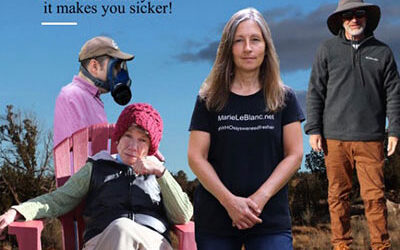
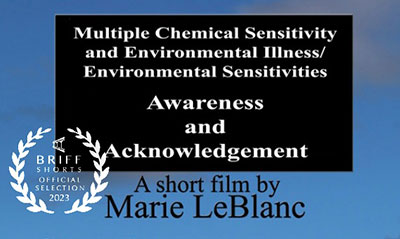
great article!
I can report that Wiggy’s sleeping bags are incredibly warm but the one I have did have a smell when I got it. the smell was kind of waxy – a bit like mild crayon smell (not as bad as actual crayons). I’ve only washed it a few times because in spite of them saying it is ok to wash, I worry it may get damaged. the smell has faded a good deal. I was able to use it when new in spite of the smell but I had been improving MCS-wise for a year at that point. I don’t think it would have been tolerable during severe MCS.
That said, it’s the warmest thing I have ever slept in and if one could detox it, it may be ideal for someone living outside in winter or cold season – it doesn’t get damp the way down, cotton or polyester do and if it does get wet from something, it dries very fast.
I have a Wiggy sleeping bag but I could never tolerate it. And in the process of washing it over and over, it ripped in the washing machine. I was bummed because it was expensive. Wish I could use it!!
I loved reading this article! Thank you, Lisa. Keep writing! I look forward to learning from you.
earthwalker I’m so sorry to hear that happened to you! the nylon definitely seemed vulnerable to ripping to me.
i have heard they have a good return policy and they say it is machine washable. hope you may be able to get your money back!
Really enjoyed reading this article and your sundogtales.
Thanks so much for sharing.
Thank you for the comments. It is very nice to hear that my writing was enjoyed. :)
We have camped and backpacked in the mountains for years and have a great stove that burns alcohol, sold as methyl hydrate or methanol in hardware stores. Unlike propane or other camp fuels, it has little smell, burns cleanly (only carbon dioxide and water), and, if it it spills, it evaporates cleanly without leaving a smelly residue on everything in your backpack. Unlike other stoves, an alcohol stove no moving parts to break, clean, lose, or adjust–we’ve had ours for almost 20 years with no problems. I used it frequently for the 5 years I had MCS and had no problems with it.
I don’t know which MCS stage Lisa got. But, I don’t suggest syntetic clothes and tend. In my case when I was first stage I slept one night in my old tend for alpinism. Ti was already off-gased a lot. However I got a toxic crisis (blue foot, dyspnea, etc) in the first morning.
After I was able to purchase bio-clothes (keep warm more than syntetic) and a new cotton tent than my old toxic one.
Highly energetic post, I enjoyed that bit. Will there be a
part 2?
Yes there is a part 2 and 3: https://planetthrive.com/2010/11/tent-living-part-2/ (see link at end of article). Enjoy!
Scanned your article, looks great, and looking forward to perusing in detail…nice photos, too.
Are you aware of Key Compounding Pharmacy in Federal Way, near Seattle? They compound what we need–reduced L-glutathione, B 12 (HYDROcobalamin, NOT CYANOcobalamin), Selenium, etc without preservatives, fillers, colors, emulsifiers, so on, in nasal spray to protect from or ameliorate exposures. Other forms are nebulization, suppositories, lollipops, troches, many ways to feel better. They ship to MCSers globally, and also deal with the health of pets.
ALSO, please check out http://www.braco.me. I had an 85% to 90% healing of severe, lifelong MCS, EHS, ME/CFS, and the attendant severe sensitivities and allergies when only researching who he is in October 2012. Live streaming from his center in Zagreb, Croatia is free, and presently every three to four weeks. He has over 20 years of medically and scientifically verified miracle healings and helps. He is a conduit for Divine energy through his eyes and his recorded voice, which is on YouTube, where there are many testimonials from others over the years, as well.
Many thanks.
Namaste
Clearseer